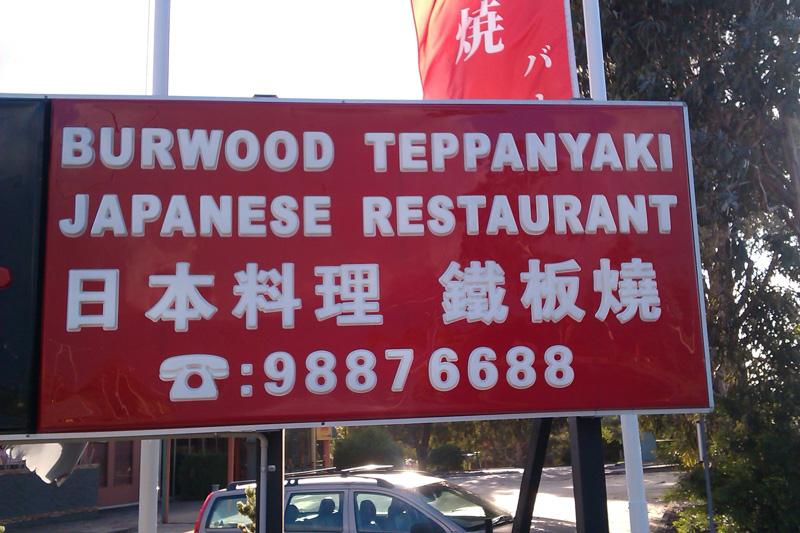Teppanyaki
Language Log 2013-03-17
If you like Japanese food, you are undoubtedly familiar with "teppanyaki", so you probably wouldn't be surprised to see a sign like this in your neighborhood, as did Jim Breen near his home in Melbourne:
The difference is that Jim Breen is a specialist on electronic Japanese / English dictionaries, so the sign made him do a double-take. Before explaining why the sign struck Jim as particularly odd, I should point out that the name "teppanyaki" consists of three elements meaning literally "iron-board-grilled/broiled/pan-fried", i.e., an iron griddle or grill for cooking food.
What we see on this sign are the following three characters: 鐡板焼, though the top right portion of the last character as represented in the font I'm using here is semi-abbreviated; the full (traditional) form, as in the photograph, would look like this: 燒. In Chinese simplified characters the entire name of this type of cooking would appear thus: 铁板烧. In Mandarin, whether written 鐡板燒 or 铁板烧, that would be pronounced tiěbǎnshāo.
In Japanese, the name for this style of cooking — which is, after all, a Japanese type of cuisine — is written 鉄板焼き or just 鉄板焼 without the final kana. in Japan, it would be extremely rare (if ever) to find the 鐡 kanji used to write the first syllable of teppanyaki. 鐡, along with 銕, 鐵 and 鋨 are known in Japan as variants (itaiji 異体字) of 鉄, but they are really only in the kanji standards because they appear sometimes in names such as 鐡男 (Tetsuo) and 鐡穴 (Kanna).
It would seem that what has happened with that Teppanyaki restaurant in Melbourne is that its proprietors (who are Chinese-Australian) simply went to their regular signage supplier and specified what was (for them) the way of writing Teppanyaki in characters, without considering that the result would be quite un-Japanese. If you Google on 鉄板焼(き) you'll get about 30 million hits. 鐡板焼 gets around 60, most of which are referring to establishments in Taiwan, etc.
I would only add that most sushi shops and Japanese restaurants I go to outside of Japan are operated by Chinese. And last week when I want to the Philadelphia Flower Show, all the people working in the big bonsai shop were speaking Chinese!
